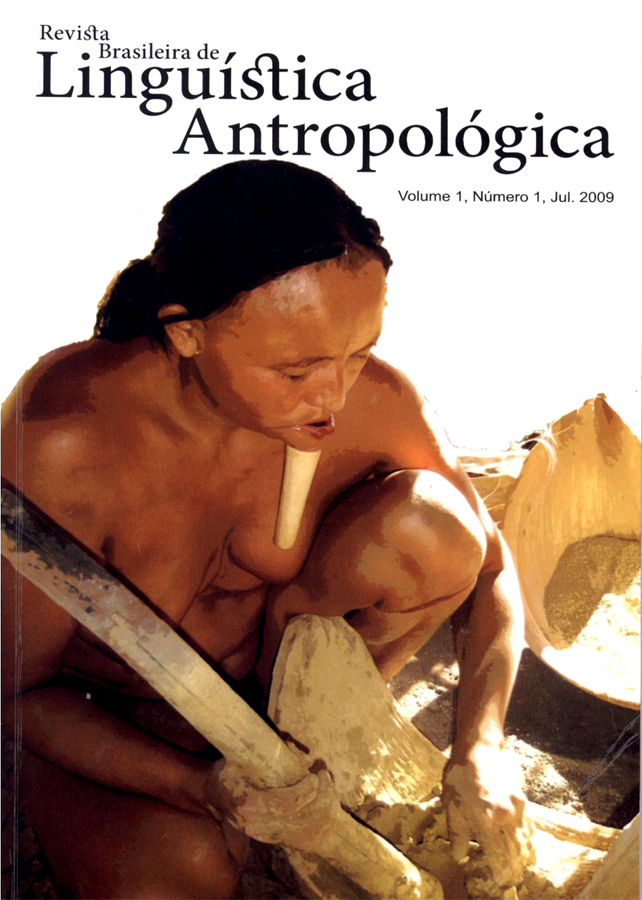Two Ergativities and Their Cultural Correlates
DOI:
https://doi.org/10.26512/rbla.v1i1.12286Keywords:
Tupí-Guaraní; Jê; ergativity; cultural correspondences; Amazonian languages.Abstract
Two Ergativities and Their Cultural Correlates proposes a distinction between two types of languages with ergative structures: a group which includes languages partially ergative from the Jê family, and another group of languages constituted mainly by languages also partially ergative from the Tupí-Guaraní family. We discuss the cultural correspondences of these two types of ergative structures, based on observations of various Amazonian indigenous groups: some Jê groups, on the one hand, and various Tupí-Guaraní groups, on the other hand, among which, the Kawahíwa, Kayabí and Araweté, whose cultures will be focused.
References
Aikhenvald, A.; R. M. W. Dixon, 1999. Other Small Families and Isolates. The Amazonian Languages. Cambridge: Cambridge University Press, 341-378.
Betts, LaVera. 1984. Esboço gramatical. In: Dicionário Parintintin-Português, Português-Parintintin. Brasília: Summer Institute of Linguistics, pp. 10-20.
Boas, Franz. 1911. Handbook of American Indian languages, Vol. 1. Bureau of American Ethnology, Bulletin 40. Washington: Government Print Office (Smithsonian Institution, Bureau of American Ethnology).
Cabral, Ana Suelly A. C.; Aryon D. Rodrigues; Lucivaldo da Silva Costa. 2003. Notas sobre ergatividade em Xikrin. Liames 4: 21-28.
Castro, Eduardo B. Viveiros de. 1986. Araweté: os deuses canibais. Rio de Janeiro: Jorge Zahar.
Derbyshire, D. 1999. Carib. In: R. M. W. Dixon and Alexandra Aikhenvald (eds.), The Amazonian Languages, Cambridge University Press, pp. 23-64.
Franchetto, B. 1990. Ergativity and nominativity in Kuikuru and other Carib Languages. In: Doris L. Payne (ed.), Amazonian Linguistics. Austin: University of Texas Press, pp. 407-427.
Jensen, Cheryl. 1990. Cross-referencing changes in some Tupí-Guaraní languages. In: Doris L. Payne(ed.), Amazonian Linguistics. Austin: University of Texas Press, pp.117-158.
Payne, Doris. 1990. Transitivity and ergativity in Panare. In: Doris L. Payne (ed.), Amazonian Linguistics. Austin: University of Texas Press, pp. 429-453.
Rodrigues, Aryon. 1999. Macro-Jê. In: R. M. W. Dixon and Alexandra Aikhenvald (eds.), The Amazonian Languages. Cambridge University Press, pp. 165-206.
Sapir, Edward. 1949 [1933]. Language. In: David G. Mandelbaum (ed.), Selected Writings of Edward Sapir in Language, Culture and Personaity. Berkeley: University of California Press, pp. 7-32.
Seki, Lucy. 1990. Kamaiurá as an active-stative language. In: Doris L. Payne (ed.), Amazonian Linguistics. Austin: University of Texas Press, pp. 367-391.
Urban, Greg. 1985. Ergativity and accusativity in Shokleng (Gê). IJAL, 51: 164-187.
Urban, Greg. 1991. A Discourse-centered Approach to Culture: Native South American Myths and Rituals. Austin: University of Texas Press.
Downloads
Published
Issue
Section
License
Copyright (c) 2012 Revista Brasileira de Linguística Antropológica

This work is licensed under a Creative Commons Attribution 4.0 International License.
Authors who publish in RBLA agree to the following terms:
a) Authors maintain the copyright and grant the journal the right of first publication, and the work is simultaneously licensed under the Creative Commons Attribution License, which allows the sharing of the work with recognition of the authorship of the work and initial publication in this journal.
b) Authors are authorized to assume additional contracts separately, for non-exclusive distribution of the version of the work published in this journal (eg, publish in an institutional repository or as a book chapter), with recognition of authorship and initial publication in this journal.
c) Authors are allowed and encouraged to publish their work online (eg, in institutional repositories or on their personal page) at any point before or during the editorial process, as this can generate productive changes, as well as increase impact and citation of the published work.










